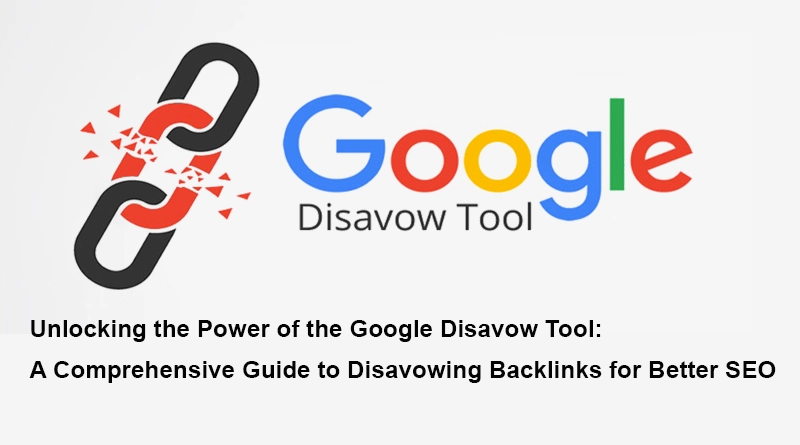Power of Google Disavow Tool Disavowing Backlinks for SEO
Introduction to the Google Disavow Tool
Backlinks for better SEO play a crucial role in search engine optimization (SEO). They are essentially incoming links from other websites to your own. High-quality backlinks can significantly boost your website’s ranking on search engine result pages (SERPs).
Low-quality or spammy backlinks can have the opposite effect, harming your SEO efforts. This is where the Google Disavow Tool comes into play.
What are backlinks and why are they important for SEO?
Before diving into the Google Disavow Tool, it’s important to understand the significance of backlinks in SEO. Backlinks are like votes of confidence from other websites, indicating that your content is valuable and trustworthy. Search engines, such as Google, consider these backlinks as a measure of your website’s authority and relevance. The more high-quality backlinks you have, the higher your chances of ranking well on SERPs.
Understanding the need for the Google Disavow Tool
While backlinks are generally beneficial. There may be instances where you encounter low-quality or spammy backlinks pointing to your website. These backlinks can negatively impact your SEO efforts and potentially lead to penalties from search engines.
In such cases, the Google Disavow Tool comes to the rescue. It allows you to disavow or distance your website from these harmful backlinks. Signaling to search engines. That you do not endorse or want to associate with them.
How to access and use the Google Disavow Tool
Accessing and using the Google Disavow Tool is relatively straightforward. Here’s a step-by-step guide to help you navigate through the process:
- Step 1: Sign in to Google Search Console: Log in to your Google Search Console account using your credentials. If you don’t have an account, create one and verify ownership of your website.
- Step 2: Select your website: Once logged in. Select the website you want to work with from the list of properties associated with your account.
- Step 3: Navigate to the Disavow Links tool: In the left-hand sidebar, click on “Links”. Then select “Disavow Links” from the drop-down menu.
- Step 4: Choose the correct version of your website. If a website has multiple versions e.g., with or without “www”. Choose the appropriate version from the provided options.
- Step 5: Upload your disavow file: Click on the “Disavow Links” button. Upload a text file containing a list of the backlinks you want to disavow. Ensure that the file follows Google’s guidelines for formatting and includes only the URLs you want to disavow.
- Step 6: Submit the disavow file: Once you’ve uploaded the file. Click on the “Submit” button to inform Google about your disavowal preferences. Note that the disavowal process takes some time to process by Google.
Steps to disavowing backlinks using the Google Disavow Tool
Now that you know how to access and use the Google Disavow Tool. It’s essential to understand the steps involved in effectively disavowing backlinks. Follow these steps to ensure a smooth and successful disavowal process:
- Step 1: Identify harmful backlinks: Conduct a thorough backlink audit using tools. Such as Google Search Console, Ahrefs, or SEMrush. Identify the backlinks that are low-quality, spammy, or potentially harmful to your website’s SEO.
- Step 2: Compile a disavow file: Create a text file where you’ll list all the URLs you want to disavow. Ensure that each URL is on a separate line and follows the correct formatting guidelines provided by Google. Include only the URLs that you genuinely want to disavow.
- Step 3: Review and refine your disavow file: Before submitting your disavow file to Google. Review it carefully to ensure accuracy. Double-check that you haven’t included any URLs that you don’t want to disavow and that the formatting is correct.
- Step 4: Upload your disavow file: Once you’re satisfied with your disavow file, log in to your Google Search Console account. Navigate to the Disavow Links tool, and upload the file following the instructions provided earlier.
- Step 5: Monitor the disavowal process: After submitting your disavow file. Keep an eye on your Google Search Console account for any updates or messages related to the disavowal process. Google will provide feedback on the success or failure of your disavowal requests.
- Step 6: Regularly review and update your disavow file: SEO is an ongoing process. And so is managing your disavow file. Review your backlinks, identify new harmful ones, and update your disavow file accordingly. This helps ensure that your website’s SEO remains in good shape.
Best practices for using the Google Disavow Tool
While using the Google Disavow Tool, it’s crucial to follow some best practices to maximize its effectiveness. Here are some recommendations to keep in mind:
- Be cautious and selective: Only disavow backlinks that are genuinely harmful or spammy. Disavowing high-quality, genuine backlinks can harm your SEO efforts. Exercise caution and thoroughly evaluate each backlink before disavowing it.
- Focus on quality over quantity: Instead of focusing on the number of backlinks. Prioritize the quality and relevance of the backlinks you aim to disavow. Quality backlinks will have a more significant impact on your website’s SEO. Than a large number of low-quality ones.
- Regularly monitor your backlink profile: Stay vigilant and regularly monitor your backlink profile using tools. Such as Google Search Console or third-party SEO tools. This allows you to identify new harmful backlinks and take prompt action by disavowing them.
- Document your disavowal decisions: Keep a record of the backlinks you’ve disavowed and the reasons behind your decision. This documentation can be useful for future reference and helps you maintain a clear overview of your disavowal activities.
- Stay informed about SEO best practices: SEO is a dynamic field, and best practices evolve. Stay updated with the latest SEO trends, guidelines, and algorithm changes. So to ensure that your disavowal efforts align with current industry standards.
Common mistakes to avoid when using the Google Disavow Tool
Here are some pitfalls to steer clear of:
- Disavowing without proper analysis: Don’t rush into disavowing backlinks without careful analysis. Take the time to evaluate each backlink’s quality and relevance to avoid disavowing valuable links.
- Disavowing entire domains: Avoid disavowing entire domains unless they are entirely spammy or harmful. Disavowing an entire domain may lead to the loss of potential high-quality backlinks from that domain.
- Overusing the disavow tool: The disavow tool used judiciously and only when necessary. Overusing it can potentially have a negative impact on your SEO. Reserve the disavow tool for genuinely harmful backlinks, rather than disavowing every link you’re unsure about.
- Neglecting regular backlink audits: Don’t forget to regularly audit your backlink profile. Neglecting this important step can result in missed opportunities to disavow harmful backlinks. Or rectify any issues that might arise.
- Failing to monitor the impact of disavowed backlinks: After disavowing backlinks. It’s crucial to monitor the impact on your website’s SEO.
Monitoring the impact of your disavowed backlinks
Once you’ve disavowed backlinks using the Google Disavow Tool, it’s essential to monitor the impact of your actions. Here’s how you can keep track of the results:
- Track changes in rankings: Monitor your website’s rankings for target keywords and observe any significant changes. Positive changes may indicate that the disavowal process is working effectively.
- Analyze organic traffic: Analyze the organic traffic to your website using tools like Google Analytics. Look for any noticeable shifts in traffic patterns, especially after disavowing backlinks. Increased organic traffic may be a positive outcome of your disavowal efforts.
- Review search engine penalties: Keep an eye on your Google Search Console account for any penalties. Or warnings related to your website. If you receive any penalties, take immediate action to rectify the issue and evaluate your disavow file if necessary.
- Monitor backlink profile: Regularly review your backlink profile using tools like Google Search Console. Or third-party SEO tools. Identify any new harmful backlinks that may have emerged and address them promptly through the disavowal process.
Other tools and resources for managing backlinks
Here are a few worth considering:
- Ahrefs: Ahrefs is a comprehensive SEO tool that provides valuable insights into your backlink profile. It helps you analyze and monitor your backlinks, identify harmful ones, and track the effectiveness of your disavowal efforts.
- Majestic: Majestic is another popular backlink analysis tool. That offers a range of features to manage backlink profiles effectively. It allows you to identify toxic backlinks, explore link-building opportunities, and monitor your backlink growth over time.
- SEMrush: SEMrush is a versatile SEO tool that offers various features, including backlink analysis and management. With SEMrush, you can conduct in-depth backlink audits, and track the performance of your backlinks. And to identify potential linking opportunities.
Conclusion
The Google Disavow Tool is a valuable resource for any website owner or SEO professional. Looking to improve their website’s SEO performance. By disavowing harmful backlinks. You can protect your website from potential penalties and enhance its overall visibility on search engine result pages.
Remember to approach the disavowal process with caution. Follow best practices, and regularly monitor the impact of your disavowal efforts. Leveraging additional tools and resources can further strengthen your backlink management strategy. Take control of your backlink profile and unlock the power of the Google Disavow Tool for better SEO.




